
Nitro Amino
1.00EGP 0.00EGP
Installation:
Free amino acids: 45%
Nitrogen:20%
Compound benefits
Nitroaminofertilizer in the form of a paste contains a high percentage of amino acids and nitrogen in a free form that is easily absorbed by all vegetable and fruit crops to stimulate metabolism and increase plant energy.
Nitroamino is characterized by providing the binding energy between amino acids necessary to bind together amino acids, enzymes, and carbohydrates, thus increasing their concentration within the plant.
Nitroamino reduces the effect of stress resulting from high temperature or frost
Nitroamino significantly increases vegetative, flowering and fruit growth, as it helps in the formation of auxins and hormones responsible for the elongation process in the stems, as well as the growth of buds and the formation of flowers and nodes.
Tetroamino significantly increases per-acre production
Dosage and rate of use:
Nitroamino is added at a rate of 1-2 g/liter of water
Based on 0 reviews
|
|
|
0% |
|
|
|
0% |
|
|
|
0% |
|
|
|
0% |
|
|
|
0% |
Related products
Insecticide:
Active ingredient: Andoxocarb
Chemical group, oxadiazine
Definition: An insecticide that is a type of insect pest. It is used on many field crops, vegetables, and fruits, and is suitable for integrated control programs. Indexoside is available in the form of an emulsifiable concentrate, and the use of natural solvents makes the compound’s efficiency higher than the permeability through the skin of the larvae, as well as the local permeability in the leaf epidermis, which facilitates the access of the active substance to the larvae located under the epidermis of the leaf, such as (tunnel makers - Tuta absoluta).
Method of action: Indexoside acts on contact, is contagious, and has a rapid effect
Indexoside is highly effective on all larval stages
It is very effective on newly hatched worms, and it also affects a good percentage of eggs
Indexoside closes the sodium channels inside the nerves, so the larva stops feeding and moving, becomes paralyzed after 4 hours, and dies within a day. 2 days / 4 days.
Indexoside is from a modern group of chemicals that have a great effect and effectiveness on insects (especially lepidopteran worms) that have gained immunity from other carbamate, phosphorous, and pyrethroid compounds, and moult inhibitors.
Pre-harvest period, usage rate, crop pest
3 days 105 cm/acre sugar beet cotton leaf cycle
Global recommendations:
Usage rate, crop lesion
3 days, 25 cm/100 liters of water, grape fruit cycle, grapes
3 days 25 cm / 100 liters of water Butterfly potato tubers Potatoes
3 days, 26.3 cm/100 liters of water, fruit worms, vegetable cycle, cotton paper cycle, tomatoes and peppers
6 days 26.3 cm/100 liters of water European corn cycle Corn
6 days 105 cm/acre cotton leafworm
المادة الفعالة : ابعيداگلوبرید ۲۰
المجموعة الكيماوية انيونيكوتينويد
التعريف مبيد حشري نيونيكوتينويديكافح العديد من أنواع الأفات الحشرية ويستخدم على العديد من المحاصيل الحقلية والخضر والفاكهة .
مناسب لبرامج المكافحة المتكاملة . يحافظ على البيئة والأعداء الحيوية نظرا لفاعليته في مكافحة الأفات فانه يزيد المحصول ويحسن جودته مناسبا في التصدير
65 in stock
سماد ورقي
جيل التركيب نيتروجين : ۶۲۰ – احماض امينية 45 % . ماغنسيوم %۱
امينوجيل سماد ورقي في صورة جيل يحتوي على نيتروجين وماغنسيوم واحماض أمينية حرة لجميع محاصيل الخضر والفاكه لتنشيط التمثيل الغذائي وزيادة طاقة النبات .
يحتوي على تركيز عالي من النيتروجين والاحماض الأمينية الحرة التي تقلل من تأثير الإجهاد الناتج عن الحرارة العالية والصقيع . يزيد بشكل عالي من النمو الخضري الزهري والثمري .
يساعد على تكوين الأوكسينات المسئولة عن عملية الاستطالة في السيقان وكذلك نمو البراعم يحتوي على عنصر الماغنسيوم الذي يدخل في عملية تكوين الكلوروفيل . برفع من انتاجية الفدان بشكل ملحوظ .
Usage rates
يضاف من 1-5 سم / لتر ماء ويكرر كل 10 ايام
75 in stock
Installation:
Nitrogen :13%
Potassium: 46%
A fertilizer rich in potassium in the purest and most powerful form of potassium for absorption, which is the form of potassium nitrate. The (Elec) product is distinguished by containing potassium nitrate with a purity of 99.9%. Therefore, the compound is used as a spray on the shoots or ground fertilization to help hold the flowers and size the fruits.
Fertilizer (Potassium Alic) provides additional benefits including
High purity and low percentage of salts. – Humidity level is low. – Low acidity, rapid flow. – Rapid dissolution
– High percentage of nitrogen and potassium
Potassium nitrate (Potassium Alec) is easy and safe to use on crops, flowers, vegetables, strawberries, plants (indoor and outdoor), teak, potatoes, fruit trees, grapes, citrus fruits, pineapples, cotton, bananas, mangos, olives, tomatoes, potatoes, home gardens and green spaces.
يوفر اليك K Many positive effects such as, increased root growth, improves drought resistance, reduces water loss and wilting, improves winter cold resistance and improves resistance to pests and diseases.
Installation:
26.1%: phosphorus
22.7%: potassium
Compound features
Anti fertilizer is fast absorbed because the elements carry amino acids, carboxylic acids and monosaccharides. The compound is characterized by the presence of phosphorus in two forms: Phosphate as nutrition and phosphate as prevention and treatment of: Fungal diseases such as: Downy mildew and mealybug diseases in onions Cucumber Cantaloupe Grapes
3- Diseases of the fungus of Fitunshra such as: late blight in potatoes and tomatoes
2- Diseases of pythium fungi and fusarium on: seedlings of vegetables and fruits (root rot).
It also contains potassium and also zinc and magnesium, so the Ante compound has a major role in the plant, especially in raising plant immunity, and also works Ante fertilizer to raise the efficiency of the flowering process, nodes, growth and development of fruits in different crops, which increases the size of the crop and quality in terms of color, shape and taste
Dosage and rate of use:
Fertilization (root rot) immediately after seedling and 500 cm / acre
. Fertilization ( Niol Fusarium ) : liter / acre .
Spraying (fungal infection such as downy mildew, mealybug and pollin): 500 cm / 200 liters of water
94 in stock
Compound benefits
FunsoHumic is a fertilizer that contains phosphorus in two forms: Porea Novsoric, the first is phosphate for nourishment and stimulating the roots and the second is for protecting against root organs. The compound also contains a high percentage of humic to stimulate the roots.
Phosphohumic is a fertilizer rich in potassium. It is a source of potassium phosphate and potassium humate. Therefore, phosphohumic helps in developing a strong plant.
Usage rates: kg of randan after transplanting.
99 in stock
Installation:
Phosphorus: 9%
Potassium: 47%
Compound benefits
Phos-potassium fertilizer is characterized by its rapid absorption, therefore, because the elements are loaded with amino acids, carboxylic acids, and monosaccharides.
The compound is characterized by the presence of phosphorus in two forms: phosphate as a nourishment and phosphate as a prevention and treatment of
Fungal diseases such as: downy and powdery mildew diseases in onions, cucumbers, cantaloupes, and grapes
Phytoncera fungal diseases, such as: late blight in potatoes and tomatoes
Pythium and Fusarium fungal diseases on: vegetable and fruit seedlings (root rot)
It also contains potassium, as well as zinc and magnesium. Therefore, the potassium phosphate compound has a major role in plants, especially in raising the plant’s immunity. Potassium phos fertilizer also works to increase the efficiency of the process of flowering, setting, and growth of the fruit stage in different crops, which increases the size of the crop and the quality in terms of color. The shape and taste
Dosage and frequency of use:
Application and time of use, usage rates and yield
Foliar spraying every 7 days during the crop growth period (vegetative, floral, fruitful) 1-3 cm/liter of water for vegetables
(tomatoes - potatoes - onions - cucumbers - cantaloupe)
Fertilizing with water. Irrigation 3 days after transplanting. Repeat 2 times a week. 1-1/2 liter/acre. Vegetables (after transplanting)
Foliar spraying every 7 days during the period of vegetative growth, flowering, and fruiting. 2-4 cm/liter of water for fruit and ornamental plants.
The addition is made with head water every 10 days during the growing season, 5 cm per 8 liters for fruit seedlings and ornamental plants (seedlings).
Nitrogen: 10%
Phosphorus: 30%
Potassium: 5%
Compound benefits
Safety Foss fertilizer is characterized by containing nitogen (urea phosphate), phosphorus, and potassium (potassium nitrate) in a pure form with a delay in absorption. It is also loaded with a high percentage of amino acids, monosaccharides, and carboxylic acids that facilitate and facilitate the absorption of major and minor elements through the leaves.
Safety Arc is characterized by the presence of a high percentage of phosphorus, which facilitates absorption. Phosphorus is included in the formation of energy-working materials. It also works to stimulate the roots. Phosphorus is also important for the formation of flowers and increasing fruit set. It also helps in coloring and ripening the fruits.
Safetyfos contains amino acids that help the plant to form a high concentration of hormones and enzymes and reduce the effect of stress on the plant. Safety Foss fertilizer contains high levels of microelements that help in treating the deficiency of elements in plants. Zinc and magnesium also have a significant enzymatic role that increases plant immunity.
Usage rates
Times of use: Drip irrigation, foliar spray per 100 liters of crop water
3-5 times 1 liter/acre 50-150 cm vegetables
4-6 times 1-2 liters/acre 50-200 cm of fruit
Installation:
Nitrogen:12%
Phosphorus: 12%
potassium:12%
Compound benefits
Vera fertilizer is characterized by containing balanced proportions of the major elements: nitrogen - phosphorus - potassium in the form of an easy-to-absorb grain. It is also loaded with a high percentage of amino acids, monosaccharides, and carboxylic acids, which expand and facilitate the absorption of major and minor elements through the leaves. Vera excels
A- With a high percentage of nitrogen, which facilitates foliar absorption and helps in the formation of a strong vegetative system.
2- The presence of a high percentage of phosphorus, which plays an important role in the flowering process and also works to warm the plant
3- Potassium, which facilitates foliar absorption, plays an important and major role in transporting nutrients to and from the cell. It also helps in the absorption of water, which increases the size of the fruits and the speed of their ripening. Stress over the news
Vera fertilizer contains amino acids that help the plant form a high concentration of hormones and enzymes and reduce the effect of...
Usage rates
Times of use: Drip irrigation, foliar spray per 100 liters of crop water
3-5 times 1 liter/acre 50-150 cm vegetables
4-6 times 1-2 liters/acre 50-200 cm of fruit
Installation
Nitrogen:10%
phosphorus:5%
Potassium: 25%
Magnesium: 1%
Compound benefits
Safety potash fertilizer is characterized by containing nitrogen without borate
Phosphorus is easily absorbed, and potassium is in a high percentage (potassium nitrate) in its pure form
Easy to absorb, as it is loaded with a high percentage of amino acids, monosaccharides, and carboxylic acids that accelerate and facilitate the absorption of macro and micro elements through the leaves.
Safety Potash is characterized by the presence of a high percentage of potassium, which facilitates absorption
Potassium plays an important and significant role in transporting nutrients to and from the cell. It also helps absorb water, which increases the size of the fruits and the speed of their ripening.
Safety Potash contains amino acids that help the plant produce a high concentration of hormones and enzymes and reduce the effect of stress on the plant.
Safety potash fertilizer contains microelements in a high percentage that helps in treating the deficiency of elements in plants. Zinc and magnesium also have a major enzymatic role that increases plant immunity.
Usage rates
Times of use: Drip irrigation, foliar spray per 100 liters of crop water
3-5 times 1 liter/acre 50-150 cm vegetables
4-6 times 1-2 liters/acre 50-200 cm of fruit
Installation:
نيتروجين : %6
فوسفور: 6 %
بوتاسيوم: 43 %
Benefits of the compound:
Compound benefits
Manufactured from high-quality raw materials that are soluble and quickly absorbed
.سماد يحتوي عالي نسبه عالية من البوتاسيوم غني بنترات البوتاسيوم سريع الذوبان والامتصاص لذلك يسخدام في تحجيم الثمار وزياده الانتاج
.سماد مصدر الفوسفور سريع الذوبان والامتصاص
. High-purity crystalline fertilizer that is completely soluble in water
.حامضى التاثير مما يزيد من صلاحية العناصر الصغرى والكبرى للامتصاص
. يزيد التفريع في كل من شتلات محاصيل الخضار والفاكهة
Usage rates
| stage to use | Dosage (kg/acre/day) | The crop |
| Immediately after transplanting | 2-3 | Vegetables |
| Before flowering | 2-4 | the fruit |
| Branching stages | 1.5-2 | Field crops |

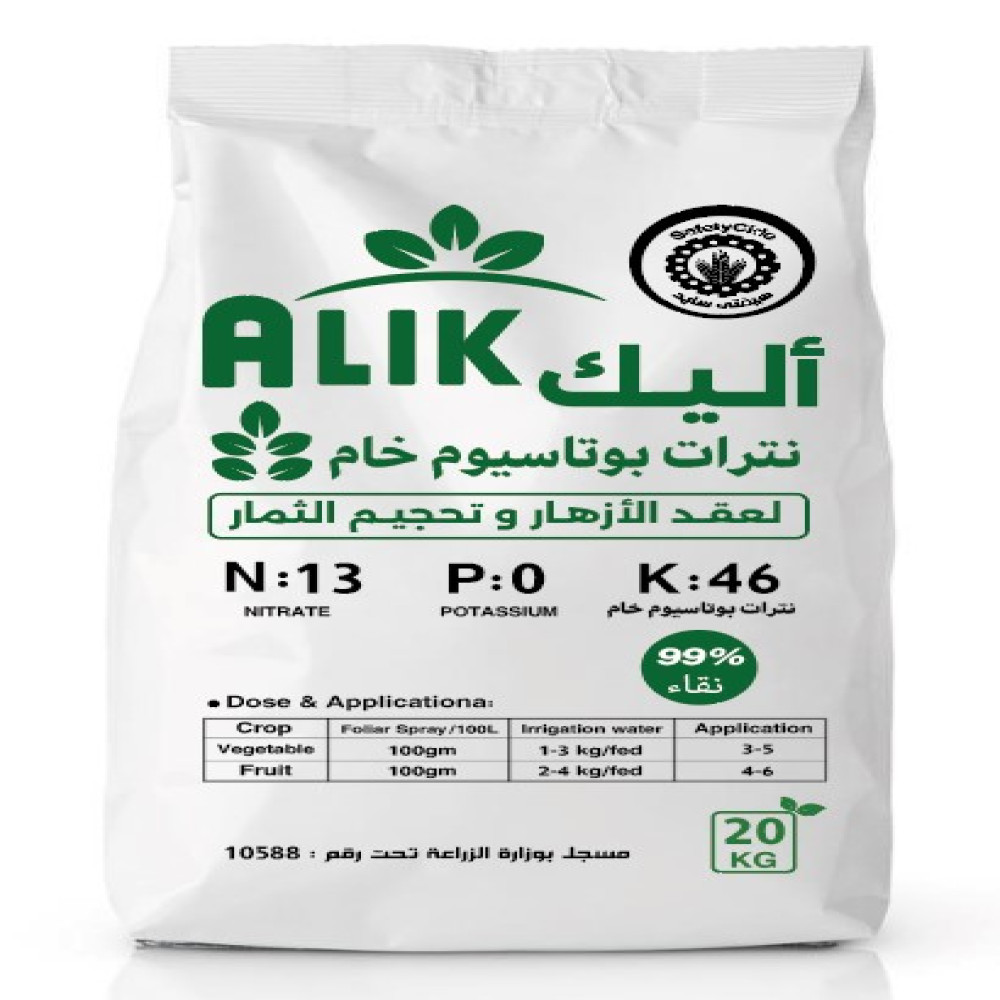
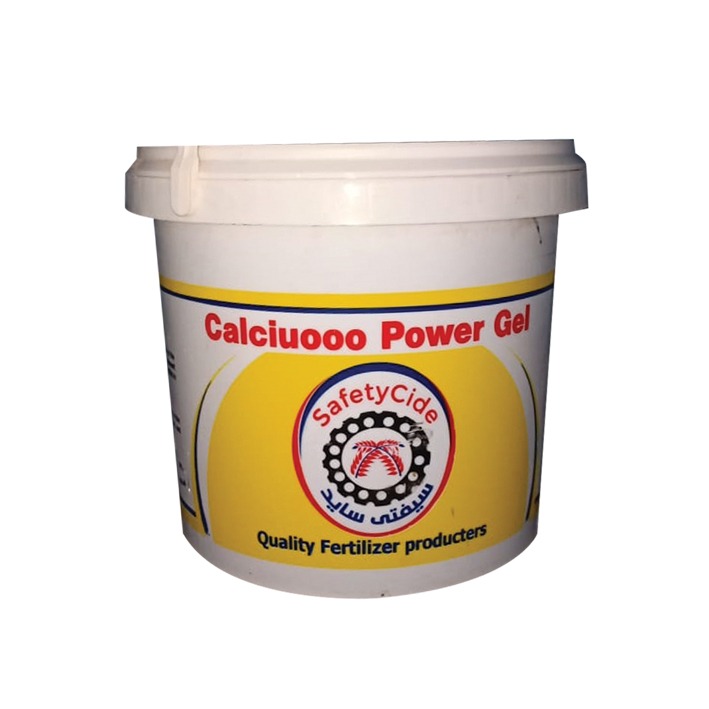



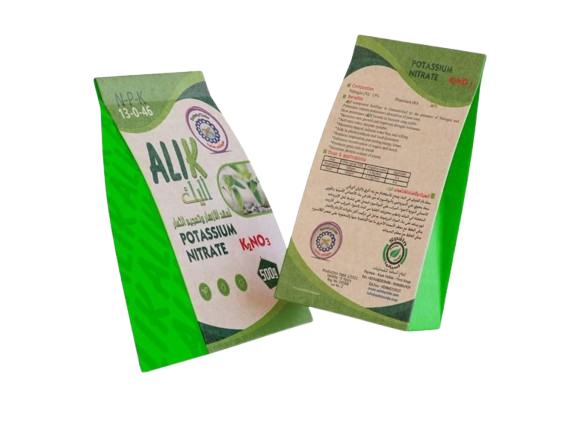
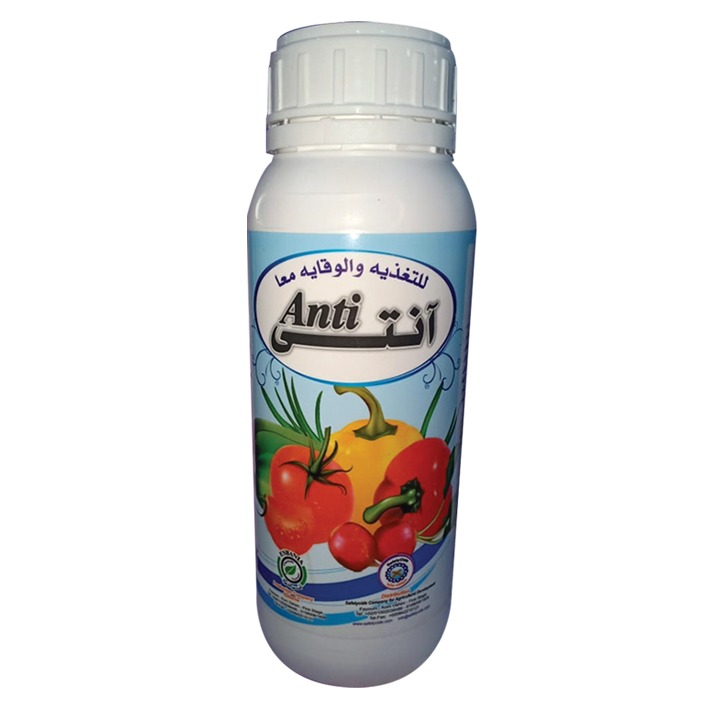





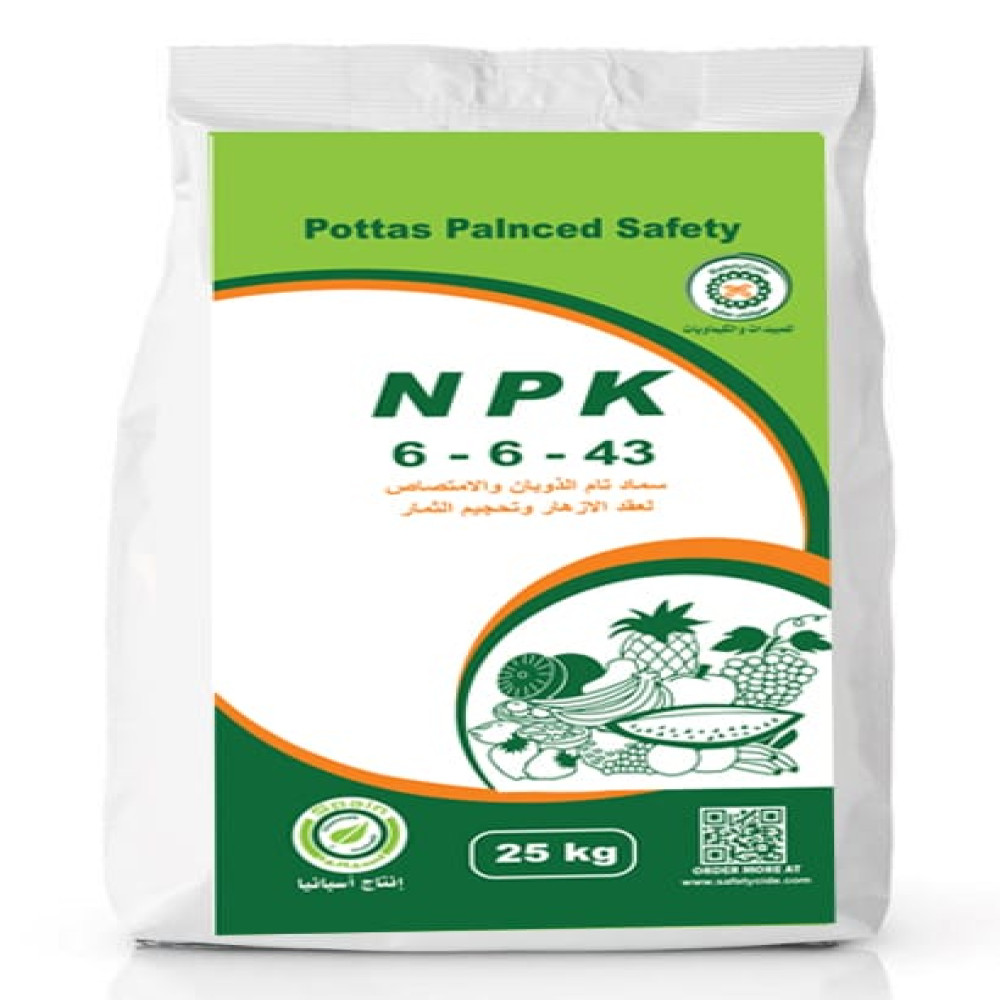
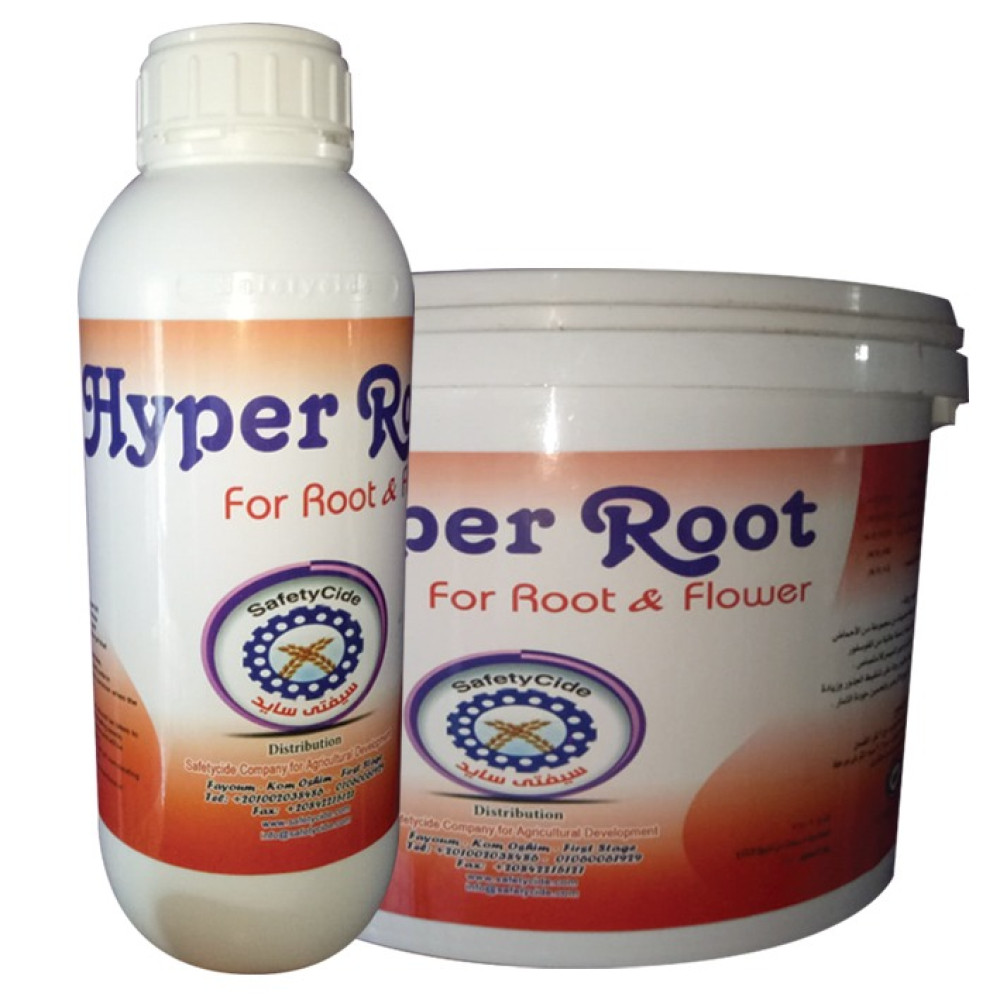
Reviews
There are no reviews yet.